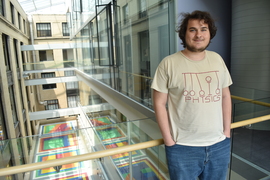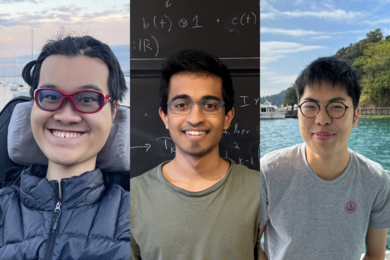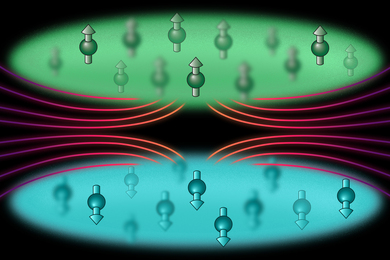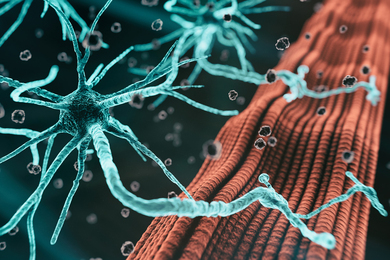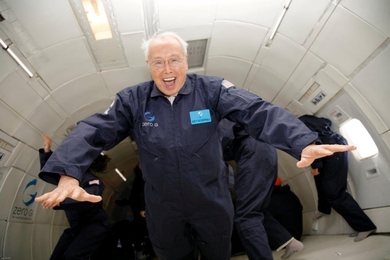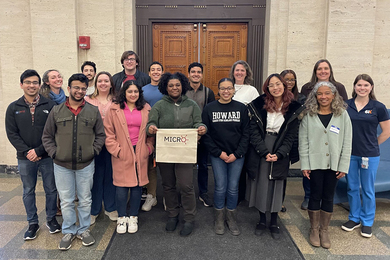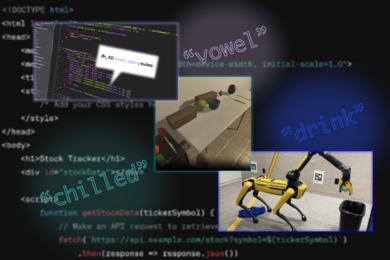Newton's third law of motion states that for every action, there is an equal and opposite reaction. The basic physics of running involves someone applying a force to the ground in the opposite direction of their sprint.
For senior Olivia Rosenstein, her cross-country participation provides momentum to her studies as an experimental physicist working with 2D materials, optics, and computational cosmology.
An undergraduate researcher with Professor Richard Fletcher in his Emergent Quantum Matter Group, she is helping to build an erbium-lithium trap for studies of many-body physics and quantum simulation. The group’s focus during this past fall was increasing the trap’s number of erbium atoms and decreasing the atoms’ temperature while preparing the experiment’s next steps.
To this end, Rosenstein helped analyze the behavior of the apparatus’s magnetic fields, perform imaging of the atoms, and develop infrared (IR) optics for future stages of laser cooling, which the group is working on now.
As she wraps up her time at MIT, she also credits her participation on MIT’s Cross Country team as the key to keeping up with her academic and research workload.
“Running is an integral part of my life,” she says. “It brings me joy and peace, and I am far less functional without it.”
First steps
Rosenstein’s parents — a special education professor and a university director of global education programs — encouraged her to explore a wide range of subjects that included math and science. Her early interest in STEM included the University of Illinois Urbana-Champaign’s Engineering Outreach Society, where engineering students visit local elementary schools.
At Urbana High School, she was a cross-country runner — three-year captain of varsity cross country and track, and a five-time Illinois All-State athlete — whose coach taught advanced placement biology. “He did a lot to introduce me to the physiological processes that drive aerobic adaptation and how runners train,” she recalls.
So, she was leaning toward studying biology and physiology when she was applying to colleges. At first, she wasn’t sure she was “smart enough” for MIT.
“I figured everyone at MIT was probably way too stressed, ultracompetitive, and drowning in psets [problem sets], proposals, and research projects,” she says. But once she had a chance to talk to MIT students, she changed her mind.
“MIT kids work hard not because we’re pressured to, but because we’re excited about solving that nagging pset problem, or we get so engrossed in the lab that we don’t notice an extra hour has passed. I learned that people put a lot of time into their living groups, dance teams, music ensembles, sports, activism, and every pursuit in between. As a prospective student, I got to talk to some future cross-country teammates too, and it was clear that people here truly enjoy spending time together.”
Drawn to physics
As a first year, she was intent on Course 20, but then she found herself especially engaged with class 8.022 (Physics II: Electricity and Magnetism), taught by Professor Daniel Harlow.
“I remember there was one time he guided us to a conclusion with completely logical steps, then proceeded to point out all of the inconsistencies in the theory, and told us that unfortunately we would need relativity and more advanced physics to explain it, so we would all need to take those courses and maybe a couple grad classes and then we could come back satisfied.
“I thought, ‘Well shoot, I guess I have to go to physics grad school now.’ It was mostly a joke at the time, but he successfully piqued my interest.”
She compared the course requirements for bioengineering with physics and found she was more drawn to the physics classes. Plus, her time with remote learning also pushed her toward more hands-on activities.
“I realized I’m happiest when at least some of my work involves having something in front of me.”
The summer of her rising sophomore year, she worked in Professor Brian DeMarco’s lab at the University of Illinois in her hometown of Urbana.
“The group was constructing a trapped ion quantum computing apparatus, and I got to see how physics concepts could be used in practice,” she recalls. “I liked that experimentalists got to combine time studying theory with time building in the lab.”
She followed up with stints in Fletcher’s group, a MISTI internship in France with researcher Rebeca Ribeiro-Palau’s condensed matter lab, and an Undergraduate Research Opportunity Program project working on computational cosmology projects with Professor Mark Vogelsberger's group at the Kavli Institute for Astrophysics and Space Research, reviewing the evolution of galaxies and dark matter halos in self-interacting dark-matter simulations.
By the spring of her junior year, she was especially drawn to doing atomic, molecular, and optical (AMO) experiments experiments in class 8.14 (Experimental Physics II), the second semester of Junior Lab.
“Experimental AMO is a lot of fun because you get to study very interesting physics — things like quantum superposition, using light to slow down atoms, and unexplored theoretical effects — while also building real-world, tangible systems,” she says. “Achieving a MOT [magneto-optical trap] is always an exciting phase in an experiment because you get to see quantum mechanics at work with your own eyes, and it’s the first step towards more complex manipulations of the atoms. Current AMO research will let us test concepts that have never been observed before, adding to what we know about how atoms interact at a fundamental level.”
For the exploratory project, Rosenstein and her lab partner, Nicolas Tanaka, chose to build a MOT for rubidium using JLab’s ColdQuanta MiniMOT kit and laser locking through modulation transfer spectroscopy. The two presented at the class’s poster session to the department and won the annual Edward C. Pickering Award for Outstanding Original Project.
“We wanted the experience working with optics and electronics, as well as to create an experimental setup for future student use,” she says. “We got a little obsessed — at least one of us was in the lab almost every hour it was open for the final two weeks of class. Seeing a cloud of rubidium finally appear on our IR TV screen filled us with excitement, pride, and relief. I got really invested in building the MOT, and felt I could see myself working on projects like this for a long time in the future.”
She added, “I enjoyed the big questions being asked in cosmology, but couldn’t get over how much fun I had in the lab, getting to use my hands. I know some people can’t stand assembling optics, but it’s kind of like Legos for me, and I’m happy to spend an afternoon working on getting the mirror alignment just right and ignoring the outside world.”
As a senior, Rosenstein’s goal is to collect experience in experimental optics and cold atoms in preparation for PhD work. “I’d like to combine my passion for big physics questions and AMO experiments, perhaps working on fundamental physics tests using precision measurement, or tests of many-body physics.”
Simultaneously, she’s wrapping up her cosmology research, finishing a project in partnership with Katelin Schutz at McGill University, where they are testing a model to interpret 21-centimeter radio wave signals from the earliest stages of the universe and inform future telescope measurements. Her goal is to see how well an effective field theory (EFT) model can predict 21cm fields with a limited amount of information.
“The EFT we’re using was originally applied to very large-scale simulations, and we had hoped it would still be effective for a set of smaller simulations, but we found that this is not the case. What we want to know now, then, is how much data the simulation would have to have for the model to work. The research requires a lot of data analysis, finding ways to extract and interpret meaningful trends,” Rosenstein says. “It’s even more exciting knowing that the effects we’re seeing are related to the story of our universe, and the tools we’re developing could be used by astronomers to learn even more.”
After graduation, she will spend her summer as a quantum computing company intern. She will then use her Fulbright award to spend a year at ENS Paris-Saclay before heading to Caltech for her PhD.
Running past a crisis
Rosenstein credits her participation in cross country for getting through the pandemic, which delayed setting foot on MIT’s campus until spring 2021.
“The team did provide my main form of social interaction,” she says. “We were sad we didn’t get to compete, but I ran a time trial that was my fastest mile up to that point, which was a small win.”
In her sophomore year, her 38th-place finish at nationals secured her a spot as a National Collegiate Athletic Association All-American in her first collegiate cross-country season. A stress fracture curtailed her running for a bit until placing 12th as an NCAA DIII All-American. (The women’s team placed seventh overall, and the men’s team won MIT’s first NCAA national title.) When another injury sidelined her, she mentored first-year students as team captain and stayed engaged however she could, while biking and swimming to maintain training. She hopes to keep running in her life.
“Both running and physics deal a lot with delayed gratification: You’re not going to run a personal record every day, and you’re not going to publish a groundbreaking discovery every day. Sometimes you might go months or even years without feeling like you’ve made a big jump in your progress. If you can’t take that, you won’t make it as a runner or as a physicist.
“Maybe that makes it sound like runners and physicists are just grinding away, enduring constant suffering in pursuit of some grand goal. But there’s a secret: It isn’t suffering. Running every day is a privilege and a chance to spend time with friends, getting away from other work. Aligning optics, debugging code, and thinking through complex problems isn’t a day in the life of a masochist, just a satisfying Wednesday afternoon.”
She adds, “Cross country and physics both require a combination of naive optimism and rigorous skepticism. On the one hand, you have to believe you’re fully capable of winning that race or getting those new results, otherwise, you might not try at all. On the other hand, you have to be brutally honest about what it’s going to take because those outcomes won’t happen if you aren’t diligent with your training or if you just assume your experimental setup will work exactly as planned. In all, running and physics both consist of minute daily progress that integrates to a big result, and every infinitesimal segment is worth appreciating.”




